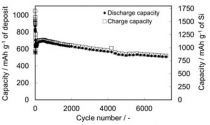Long-life negative silicon anode synthesis for next-generation lithium-ion batteries

- researcher's name
- affiliation
-
- research field
-
Device related chemistry,Nanobioscience,Electronic materials/Electric materials
- keyword
-
background
In order to promote utilization of renewable energies, which have seen a sudden increase in popularity since the Great East Japan Earthquake, there is an indispensable need for storage devices that can capture such energy. Differing from pumped power generation and other forms of power generation, next-generation lithium-ion batteries are gaining great prominence as small-scale dispersed power sources. However, a peak has already been reached in terms of efforts to increase the capacity of current next-generation lithium-ion batteries. It is thus desirable to proceed with the development of next-generation storage batteries. There are high expectations for synthesizing tin and silicon with lithium to create magnetic materials for storage batteries with high capacities, but this process faces the problem that degradation becomes accelerated due to great volume changes taking place during charging or discharging and that sufficient cycling characteristics cannot be established.
summary
This technology has successfully produced composite products merging silicon and organo-mineral complex substances at the micro-level through the simultaneous reductive decomposition of organic solvents and reduction of silicon. The resulting silicon electrodes are composed of amorphous silicon made of oxygen and carbon that has been diffused at the nano-scale. Even after 7,000 cycles, this technology shows extremely superior output figures of approximately 800 mAh/g.
application/development
Because the composite silicon electrodes made through this method possess comparatively high discharged capacity and superior repeating characteristics, the method could potentially create second-generation batteries with capacities ever greater than conventional second-generation batteries through the combination of next-generation positive electrodes with second-generation batteries. In addition, because these electrodes differ from conventional electrodes for which powders are applied to current collectors and because the electrodes are directly deposited on current collectors, the method holds the possibility of greatly changing electronic manufacturing processes.
predominance
Even silicon electrodes made of alloyed electrode materials, once thought not to be able to possess sufficient cycling characteristics due to the great changes made to volume during charging or discharging, can produce superior charge-discharge behavior of over 7,000 cycles.
purpose of providing seeds
Sponsord research, Collaboration research, Technical consultation
material
same researcher's seeds
-
 Field Effect Transistor Sensor
Field Effect Transistor Sensor
-
 Manufacturing of nano particle array substrates
Manufacturing of nano particle array substrates
-
 Hard-gold film technology for the realization of low-resistance and high mechanical strength
Hard-gold film technology for the realization of low-resistance and high mechanical strength
-
 All Wet ULSI manufacturing process
All Wet ULSI manufacturing process
-
 Evaluating lithium-ion battery (LIB) cell degradation using an impedance measurement
Evaluating lithium-ion battery (LIB) cell degradation using an impedance measurement
-
 Production technology development for the creation of a next-generation laminated lithium-ion battery
Production technology development for the creation of a next-generation laminated lithium-ion battery
-
 Monitoring Chemical Balance in Epidermal Barriers
Monitoring Chemical Balance in Epidermal Barriers
-
 Development of Biosensing Technology for Food Safety
Development of Biosensing Technology for Food Safety
-
 Development of magnetic nanoparticles for cancer care
Development of magnetic nanoparticles for cancer care
-
 Chemical Health Monitor Kind to Skin
Chemical Health Monitor Kind to Skin
-
 Seeing mental stress from invisible substances
Seeing mental stress from invisible substances
-
 Battery Diagnosis by Square-Current Electrochemical Impedance Spectroscopy
Battery Diagnosis by Square-Current Electrochemical Impedance Spectroscopy
posted:
2014/05/21




